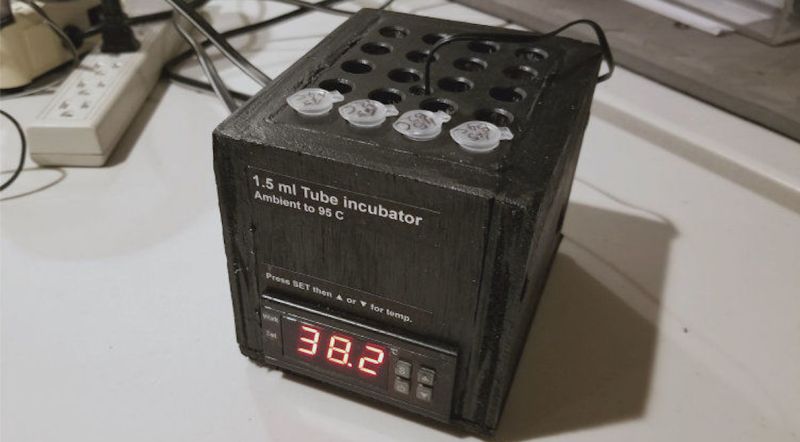[abizar] lucked into some aluminum blocks, one of which had test-tube-sized holes in it–just the thing to turn into a dry bath for his biology projects.
He stuck a 100W positive temperature coefficient heater into the bottom of the block using silicone glue, and the heater heated the block up in around half an hour. He connected a temperature controller to maintain the temperature at an ambient 95C, with a controller monitoring a thermistor to keep the block within the pre-determined range. The heater has an auto shutoff if it got too hot, so [abizar] felt safe keeping the dry bath on, unmonitored.
The aluminum block sits in a plywood box lined with rubber from an inner tube, with the heater underneath the block and the temperature controller underneath that, separated by more plywood from the heat. The result? A dry, temperature regulated bath for 20 1.5ml test tubes.
Looking to tool up? Check out the plethora of biohacking tools on Hackaday, including a DIY CO2 incubator, a basic biohacker’s toolkit, and a cheap electrophoresis rig.
















Heh, this reminded me of something I did a while back. I got a big aluminium block and thermal pasted it to the CPU of an old PC. Then I wrote some bare metal code to busyloop or halt according to thermal monitoring code I chopped out of Linux to maintain a set temperature. No fan, just the radiative, conductive, or ambient convective cooling of the block.
I wanted to demonstrate to someone that the electricity used in a computer is turned primarily into heat but the heat doesn’t have to go to waste. Sorry that I don’t have a proper writeup, I don’t have the code or the hardware anymore and I doubt I’d be able to get it back. It was actually pretty crappy because I didn’t bother to filter noise from the temperature sensor or have a proper PID loop, I just polled constantly to see if the CPU should be doing more or sleeping more, and if you had a load on it and then removed it it would spike, and then sleep too long, etc. It plotted the temperature as a graph in text mode so the oscillation was pretty obvious.
We actually let it get really hot, up to the limit of the sensor (I think 125C) to see if it would blow the CPU but it lived! It was probably internally managing its temperature somehow but it still stayed at the sensor limit. If one could make it do /useful/ computation as well as heat something, that would be an interesting project.
Definitely not as fancy as this project and wouldn’t belong anywhere near sterile conditions. This thing is truly a work of art! I hope [abizar] feels proud when using it.
Mining cryptocurrency is actually a pretty reasonable load for this sort of thing. “space heater that also pays me a buck or two occasionally” – nearly ideal sort of load for this, nobody cares if it doesn’t get done, so you can pid it freely, and because the primary goal is converting power to heat it doesn’t have to be optimal to be worth doing.